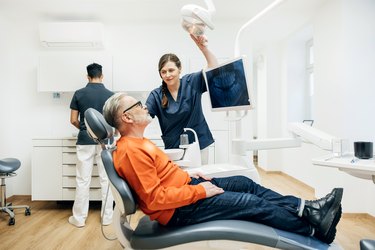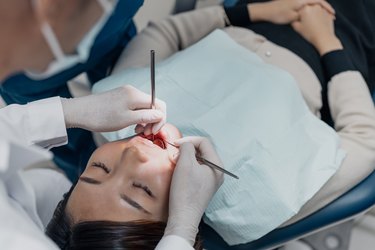
Each year, an estimated 54,000 people will develop oral cancer — i.e., cancer that starts in the mouth, according to the American Cancer Society (ACS).
While the number of new cases has risen slightly over the past few decades — in part due to the increase in the human papillomavirus (HPV) infection — "oral cancer is very treatable," says Kunal Jain, MD, an associate professor in the department of otorhinolaryngology at McGovern Medical School at UTHealth Houston.
Video of the Day
Video of the Day
Types of Oral Cancer
Oral cancer — or, more specifically, oral cavity cancer — typically starts in the mouth. It's often spoken of alongside oropharyngeal cancer, which starts in the middle of the throat, behind the oral cavity.
The oral cavity includes the lips, the inside of the lips and cheeks, the teeth, the gums, the front area of the tongue, the bony, front roof of the mouth and the area behind the wisdom teeth. The oropharynx includes the base and back of the tongue, the back of the roof of the mouth, the tonsils and the side and back walls of the throat.
There are a few different types of mouth and throat cancers, including:
- Squamous cell carcinoma, which makes up the vast majority of oral cancer. Like the name suggests, this cancer starts in the squamous cells that line the mouth and throat. If the cancer is confined to the top layer of cells in the lining, it's called carcinoma in situ; if it has spread into other, deeper layers of cells, it's called invasive squamous cell cancer.
- Verrucous carcinoma, which is found in the gums and cheeks. This cancer tends to be slow growing, and isn't likely to spread to other areas of the body.
- Minor salivary gland cancers, which start in the glands that line the mouth and throat. These include adenoid cystic carcinoma, mucoepidermoid carcinoma and polymorphous low-grade adenocarcinoma.
- Lymphomas, which start in the lymphoid (immune system) tissue in the tonsils and base of the tongue.
Risk Factors for Oral Cancer
Two of the biggest risk factors for oral cancer are heavy smoking and drinking — and people who do both are most likely to develop the disease. See more details on oral cancer risk factors:
- Tobacco use: One of the biggest risk factors for oral cancer is tobacco use — like smoking or chewing. And according to the ACS, the more you more smoke, the higher your risk of cancer.
- Alcohol use: Drinking alcohol also increases the risk of oral cancer, with heavy drinkers being more likely to develop the cancer than lighter drinkers, according to the ACS. If you drink and smoke heavily, you're about 30 times more likely to have oral cancer than people who don't smoke or drink.
- HPV: The virus is spread through sexual contact, including oral sex. Although most people will naturally clear the infection from their body within a few years, in some people, the virus will linger, where it can cause mouth and throat cancers. In fact, according to the Centers for Disease Control and Prevention, HPV is thought to cause about 70 percent of the throat cancers in the U.S.
- Sex: People assigned male at birth (AMAB) are twice as likely to have oral cancer as people assigned female at birth (AFAB), according to the ACS. Still, lifestyle habits may be at play here — people AMAB may be more likely to use tobacco and alcohol than people AFAB.
- Ultraviolet (UV) light: Lip cancer tends to be more common in people who work outdoors, and who have been exposed to sunlight for longer periods of time.
- A poor diet: A diet that is low in fruits and vegetables has also been linked to oral cancers.
Plus, keep in mind that oral health declines with age in general — while you can develop oral cancer at any age, the average age of diagnosis for oral cavity or oropharyngeal cancer is 63, according to the ACS.
Symptoms and Signs
Some of the signs and symptoms of oral cancers — both those in the mouth and throat — can include:
- A lip or mouth sore that doesn't go away
- Mouth pain or a sore throat that doesn't go away
- A lump or a thickening in the lips, mouth or cheek
- A lump that develops in the neck or the back of the throat
- Red or white patches that appear on the gums, tongue, tonsil or the lining of the mouth
- Difficulty chewing, swallowing or moving the jaw or tongue
- Numbness in the tongue, lip or mouth
- Jaw pain or swelling
- Loose teeth or tooth pain
- Poorly fitting dentures
- Changes to your voice
- Weight loss
- An earache
If any of these symptoms linger for more than two weeks, it's a good idea to visit your doctor or dentist. Keep in mind, though, that many of these symptoms can be caused by other, benign conditions, and aren't necessarily caused by cancer.
How Oral Cancer Is Diagnosed
Unlike, say, colon cancer — which can be detected with a colonoscopy — there's no screening test that can spot oral cancer. In many cases, oral cancers, particularly the smaller ones, are spotted by a dentist during a routine oral exam, says Dr. Jain.
During a teeth cleaning or checkup, for example, your dentist might notice a possible cancer lesion and do a physical exam of the area — by looking inside your mouth or feeling around the area, including your head, face and neck — for other signs of cancer. Your dentist may also use oral cancer screening dye or an oral cancer screening light to help detect abnormal cells, per the Mayo Clinic.
If your dentist or doctor suspects that you have cancer, they will likely refer you to a specialist, like an ear, nose and throat (ENT) doctor (aka otolaryngologist), who will use certain tests to make the diagnosis, including:
- A panendoscopy: While you're under anesthesia, doctor will place an endoscope down the mouth or nose to examine your mouth, throat, esophagus and windpipe. (If you have oral cancer — particularly if you have a history of tobacco or alcohol use — there's up to a 10 percent chance that you may also have cancer in the esophagus or lungs, according to the ACS.)
- Exfoliative cytology: A doctor scrapes the affected areas of the mouth, then stains the sample with a dye; if any cells look abnormal, the area will be biopsied.
- A biopsy: A doctor will remove a sample of tissue to examine it for cancer cells. During biopsy, the sample is often tested for HPV.
"The earlier you diagnose it, the lower the stage of cancer and the better the probability of a cure," says Dr. Jain. "Throat cancer caused by HPV has a higher cure rate than traditional oral cancer caused by smoking and drinking."
Stages of Oral Cancer
Once you've been diagnosed with oral cancer, your doctor will determine whether the cancer has spread to other areas of the body. This is called the staging process.
The stages of oral cancer range from stage 1 to stage 4. In general, the higher the number, the farther the cancer has spread.
- Stage 0: The cancer is in the top layer of cells in the oral cavity and oropharynx and hasn't spread into the deeper layers.
- Stage 1: The cancer is 2 centimeters (cm) or smaller, and hasn't spread to any other tissues or sites.
- Stage 2: The cancer is in between 4 cm and 2 cm in size, and hasn't spread to any other tissues or sites.
- Stage 3: With stage 3 cancer, one of two scenarios can occur:
- The cancer is larger than 4 cm. If you have oropharynx cancer, the tumors are growing into the base of the tongue, but it hasn't spread to other sites in the body.
- The cancer is any size, and — in the case of oropharynx cancer — it may have spread into nearby structures and one lymph node.
- Stage 4: With stage 4 cancer, a few scenarios can occur:
- Stage 4A: The cancer can be any size and can be growing into nearby structures. At this stage, the cancer may not have spread to the lymph nodes, or, it may have spread to one lymph node, but not beyond.
- Stage 4A: The cancer is any size and has spread to either one or more lymph nodes, but hasn't spread to distant organs.
- Stage 4B: The cancer can be any size and may have grown into nearby soft tissues or structures, including one or more lymph nodes. It hasn't spread to distant organs.
- Stage 4B: The cancer is any size, and is growing into structures such as nearby bones. It may have spread to one or more nearby lymph nodes, but it hasn't gone to distant organs.
- Stage 4C: The cancer is any size, and may have grown into nearby soft tissues. It may have also spread to nearby lymph nodes and has spread to distant sites such as the lungs.
Treatment for Oral Cancer
The treatment for oral cancer is largely based on the type of cancer you have, how much it has spread and — in the case of oropharyngeal cancer — whether you have HPV.
If you have small, early-stage oral cancer, you may only need to be treated with surgery and/or radiation. After the tumor is removed, reconstructive surgery can help restore the area that has been treated — for example, to help fill any gaps left by the tumors or replace any areas that may have been removed.
For example, if you have lip cancer, the tumor may be removed in very tiny pieces using Mohs surgery, which may not change your appearance may very much. If you have cancer on the front part of the roof of your mouth, however, you may need to have surgery to remove part of that bone (called a partial maxillectomy), which would then need to be replaced with a special type of denture or a skin graft.
If the cancer has spread to the nearby lymph nodes or grown into the surrounding tissues, you'll likely need to have surgery first — which includes removing some of the lymph nodes in the neck — followed by either radiation alone or radiation with chemotherapy (drugs that help kill cancer cells).
"For the back of the throat, or oropharynx, the treatment can be robotic surgery or radiation therapy and chemotherapy," says Dr. Jain. If the cancer can't be removed by surgery, you may be treated with radiation alone or a combination of radiation and chemotherapy.
Recovering From Oral Cancer
The treatments for oral cancer can change many aspects of a person's life, says Dr. Jain, including their appearance, speech and ability to eat. You may, for example, need to seek help from a speech therapist, who can help you swallow, or a physical or occupational therapist, who can help you cope with any fatigue you might have during your treatment.
After surgery, some people may also need to use a feeding tube, he says, which is where a dietitian and nutritionist can come in handy.
Outlook for Oral Cancer
Overall, the five-year survival rate for people with mouth and throat cancer is 68 percent, according to the National Cancer Institute (NCI) — meaning, five years after being diagnosed with the cancer, 68 percent of people are still living.
That said, the outlook largely depends on the type of oral cancer you have, and how far it has spread in the body. In general, the more localized (i.e., confined) the cancer is to the area in which it appeared, the better the survival outcome.
"We watch patients for five years after treatment," says Dr. Jain. "The highest chance of it coming back is in the first two years after treatment."
According to the NCI, the five-year survival rates for people with oral cancer are:
- 86.3 percent for people who have localized oral cancer
- 69 percent for people with regional cancer (meaning cancer that has spread to the lymph nodes, but not beyond)
- 40.4 percent for people whose cancer has spread to distant areas of the body
Preventing Oral Cancer
You can't prevent every cancer from occurring — but if you follow these lifestyle tips, you can lower the odds of developing oral cancer.
- Quit smoking or using tobacco
- Drink in moderation
- Wear sunscreen
- Get the HPV vaccine
- Eat a healthy diet full of fruits and vegetables
- Get regular dental checkups
- National Cancer Institute: "Cancer Stat Facts: Oral Cavity and Pharynx Cancer"
- American Cancer Society: "Can Oral Cavity and Oropharyngeal Cancers Be Prevented?"
- American Cancer Society: "Treatment Options for Oral Cavity Cancer by Stage"
- Cleveland Clinic: "Oral Cancer"
- American Cancer Society: "Oral Cavity and Oropharyngeal Cancer Stages"
- American Cancer Society: "Risk Factors for Oral Cavity and Oropharyngeal Cancers"
- American Cancer Society: "What Are Oral Cavity and Oropharyngeal Cancers?"
- American Cancer Society: "Key Statistics for Oral Cavity and Oropharyngeal Cancers"
- National Library of Medicine: "Oral Cancer"
- Mayo Clinic: "Oral Cancer Screening"
Is this an emergency? If you are experiencing serious medical symptoms, please see the National Library of Medicine’s list of signs you need emergency medical attention or call 911.


